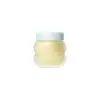What's inside
What's inside
 Key Ingredients
Key Ingredients

 Benefits
Benefits

 Concerns
Concerns

 Ingredients Side-by-side
Ingredients Side-by-side

Phytosteryl/Isostearyl/Cetyl/Stearyl/Behenyl Dimer Dilinoleate
Skin ConditioningSucrose
HumectantDiisostearyl Malate
EmollientPentaerythrityl Tetraisostearate
EmollientMicrocrystalline Wax
Emulsion StabilisingHydrogenated Poly(C6-14 Olefin)
EmollientSilica Dimethyl Silylate
EmollientOlea Europaea Fruit Oil
MaskingBis-Behenyl/Isostearyl/Phytosteryl Dimer Dilinoleyl Dimer Dilinoleate
EmollientPolyethylene
AbrasiveEthylene/Propylene/Styrene Copolymer
Citrus Limon Peel Oil
MaskingDisteardimonium Hectorite
StabilisingPolyglyceryl-2 Triisostearate
EmulsifyingSorbitan Sesquioleate
EmulsifyingPropylene Carbonate
SolventTocopheryl Acetate
AntioxidantButylene/Ethylene/Styrene Copolymer
Hippophae Rhamnoides Fruit Oil
Skin ProtectingDehydroacetic Acid
PreservativeDimethicone
EmollientPhytosteryl/Isostearyl/Cetyl/Stearyl/Behenyl Dimer Dilinoleate, Sucrose, Diisostearyl Malate, Pentaerythrityl Tetraisostearate, Microcrystalline Wax, Hydrogenated Poly(C6-14 Olefin), Silica Dimethyl Silylate, Olea Europaea Fruit Oil, Bis-Behenyl/Isostearyl/Phytosteryl Dimer Dilinoleyl Dimer Dilinoleate, Polyethylene, Ethylene/Propylene/Styrene Copolymer, Citrus Limon Peel Oil, Disteardimonium Hectorite, Polyglyceryl-2 Triisostearate, Sorbitan Sesquioleate, Propylene Carbonate, Tocopheryl Acetate, Butylene/Ethylene/Styrene Copolymer, Hippophae Rhamnoides Fruit Oil, Dehydroacetic Acid, Dimethicone
Hydrogenated Polyisobutene
EmollientPetrolatum
EmollientOlea Europaea Fruit Oil
MaskingNeopentyl Glycol Diethylhexanoate
EmollientSucrose
HumectantPolyethylene
AbrasiveDiisostearyl Malate
EmollientDiphenylsiloxy Phenyl Trimethicone
Skin ConditioningSilica Dimethyl Silylate
EmollientCandelilla Wax Hydrocarbons
Hydrogenated Castor Oil
EmollientSorbitan Sesquiisostearate
EmulsifyingMenthoxypropanediol
MaskingTocopherol
AntioxidantButylene Glycol
HumectantWater
Skin ConditioningPrunus Yedoensis Leaf Extract
Skin ConditioningChamomilla Recutita Flower Extract
MaskingHydrogenated Polyisobutene, Petrolatum, Olea Europaea Fruit Oil, Neopentyl Glycol Diethylhexanoate, Sucrose, Polyethylene, Diisostearyl Malate, Diphenylsiloxy Phenyl Trimethicone, Silica Dimethyl Silylate, Candelilla Wax Hydrocarbons, Hydrogenated Castor Oil, Sorbitan Sesquiisostearate, Menthoxypropanediol, Tocopherol, Butylene Glycol, Water, Prunus Yedoensis Leaf Extract, Chamomilla Recutita Flower Extract
 Reviews
Reviews

Ingredients Explained
These ingredients are found in both products.
Ingredients higher up in an ingredient list are typically present in a larger amount.
Diisostearyl Malate is an emollient and most often used in lip products. It comes from isostearyl alcohol, a fatty acid, and malic acid, an AHA.
As an emollient, Diisostearyl Malate helps create a thin film on your skin to trap moisture in. This helps keep your skin soft and smooth.
Olea Europaea Fruit Oil is the fixed oil obtained from the ripe fruit of the Olive. In other words - olive oil.
The primary contents of olive oil are glycerides of the fatty acids linoleic, oleic and palmitic.
Olive oil also contains antioxidants such as Vitamin E. Antioxidants may help reduce signs of aging by fighting unstable free-radical molecules. It also contains Vitamins A (retinol), D, and K.
The squalene in olive oil makes it a great emollient. Emollients help soothe and soften your skin by trapping moisture in. This makes olive oil a great skin moisturizer.
Studies show olive oil to have antibacterial and antifungal properties in low concentrations. Another study found olive oil irritated sensitive oily skin. We always recommend speaking with a professional about using this ingredient in your routine.
Due to the fatty acid content, this ingredient may not be fungal-acne safe.
Learn more about Olea Europaea Fruit OilPolyethylene is a synthetic ingredient that helps the skin retain moisture. It is a polymer.
It is also typically used within product formulations to help bind solid ingredients together and thicken oil-based ingredients. When added to balms and emulsions, it helps increase the melting point temperature.
This silica is mainly used to thicken oils and suspend particles in oils. It is not water soluble.
According to the manufacturer, it:
The manufacturer also claims this ingredient to be useful in makeup.
In lipstick formulations, this ingredient improves color payoff, reduces pigment settling, and reduces oil bleeding. This ingredient also improves the grip of powder products such as dry shampoos.
Learn more about Silica Dimethyl SilylateSucrose is a natural sugar found in fruits, vegetables, and nuts. It is the main constituent of white sugar.
In skincare, sucrose is a humectant and can be a mild exfoliant.
Sucrose is hydrophilic, meaning it attracts water. This makes it an effective humectant and helps hydrate the skin.
Studies show sugars may worsen acne-prone skin due to it disrupting the skin's natural biome. We recommend speaking with a professional if you have any concerns.
In some products such as body scrubs, sucrose is used as an gentle exfoliant.
The term 'sucrose' comes from the french word for sugar, 'sucre'.
Learn more about Sucrose